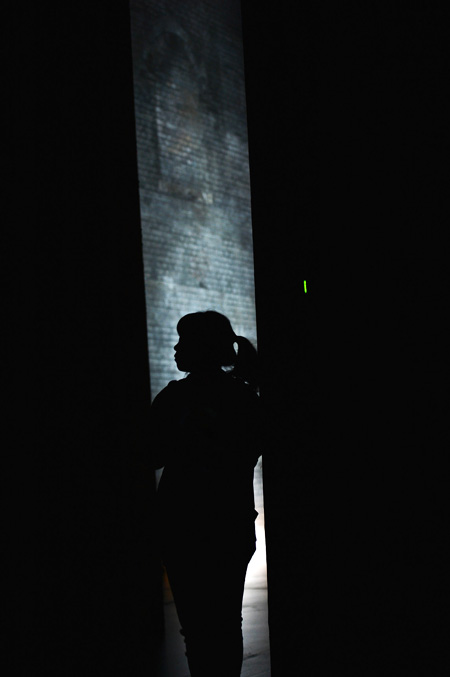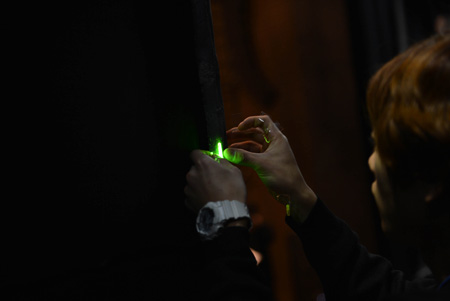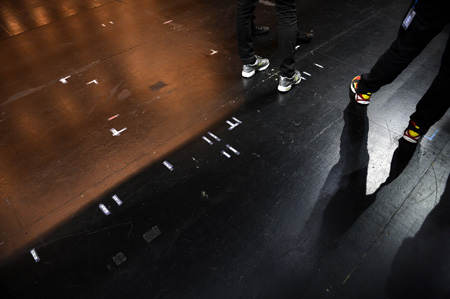
“Hero,” a locally produced musical being performed at the Blue Square in Hannam-dong, describes the life of independence fighter Ahn Jung-geun.
The idea of watching the struggle for independence on stage might not be intriguing at first, but a breathtaking chase scene between Korean independence fighters and Japanese police officers and a smooth transition from video projection to a life-size train carriage will do away with stereotypes.
The musical has a cast of 40, however, there are more people back stage, making the show flow smoothly. Bae Ji-yeon, 32, the stage manager of “Hero,” gave an exclusive backstage tour to The Korea Times and revealed the secrets of the show.

A new world opened up behind the door saying “Staff Only.” It was four hours ahead of show time, but the stage was busy with the crew checking and testing battens and curtains.
“We usually check stage, lighting and special effects every day and then go for a dinner. There is no established rule, but the backstage crew dress in black since they have to move in the dark,” the stage manager said.

A weekly check-up was going on stage and the crew were operating flying set battens following cues as if the show was in progress.
There are eight movable panels that function as ever-changing backdrops in “Hero,” alternating as the interior of a train station to the exterior of buildings. There are eight flats behind each panel, that have to moved into position following 43 cues. Cue sheets were attached to the back of each panel to help stagehands know their next move with glow-in-the-dark markings tell where the panels should be in each scene.

Bae said it was safer to carry this out manually since the crew can adjust the movements according to the actors.
“The show might seem quite high-tech from the front of the house, but many things are done manually behind the stage,” she said. “We even move the railway carriage set by hand.”

In the second act of “Hero,” a life-size train appears on stage. In the Harbin Station scene, the train looks like it is coming into the station to stop, but it is in reality a projected image of the carriage, which switches to the real set piece in the blink of an eye.
“Two projectors installed behind the station set throw visual images on screen, which drops and reveals the train set,” Bae said. “It is just a mere 20-second projection, but it is pivotal to make the audiences think the train is arriving at the station.”

Bae originally studied accounting, but her love for the theater made her change career mid path and she began as a stagehand seven years ago. She worked for major productions including “Mamma Mia!” and Chicago,” and the International Modern Dance Festival.
She joined the production last year and staged the show in four different theaters — Haeoreum Theater of the National Theater of Korea, the Opera Theater of the Seoul Arts Center, the David H. Koch Theater at the Lincoln Center in New York and currently at Blue Square.

“Each theater provides different spaces and we have to adapt to it. We usually fly the scaffolding set piece for the parkour-like chase scene, but the Haeoreum Theater did not have much space above the stage, so we had to store it in the wings,” Bae explained.
During the show, Bae sits at the stage managers desk, which has some 10 monitors that shows the stage, house and battens among others. Even an infrared monitor is installed to help her supervise what is going on during a blackout scene change.
“My sight has become poor as I have to stare at these monitors in the dark during the show,” she said.
Her responsibility covers not only stage setting, but the condition of the actors. “I am the only stage crew to participate in rehearsals and communicate between the director and crew,” she said.
Bae said staging a performance is a series of promises to show the best to the audience. “A stage manager is the one who conducts and makes sure the promises are kept through endless communication,” she said. “I feel content when the show is concluded with applause from the audience. The audiences applaud for the actors, but I think it is also for all crew behind and in front of the stage.”
The musical runs through Nov. 18. Tickets cost from 30,000 won to 50,000 won. For more information, visit www.iacom.co.kr or call (02) 2250-5900. <The Korea Times/Kwon Mee-yoo>




